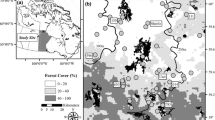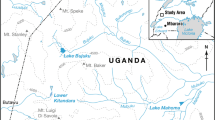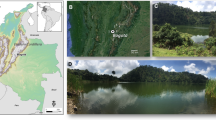Abstract
The late Quaternary diatom record from subalpine Crowfoot Lake, Banff National Park, Alberta (lat. 51° 61′N; long. 116° 31′W) has been analyzed. Results are related to independently inferred vegetation and climate changes. No diatoms were found in the basal diamict that predates 11330 14C yr BP. Very few occur until ca. 10 10014 C yr BP probably due to the short time between de-glaciation and an advance of the Crowfoot Glacier during the ‘Younger Dryas Chron’. Initial pioneering species were characteristic of alkaline water and calcareous organic sediments. They appeared as sediments became organic and laminated suggesting increasing water clarity, and as the Pinus-dominated forest expanded and the climate warmed. After ca. 9060 14C yr BP diatom numbers increased rapidly, reaching a maximum prior to the Mazama tephra; they remained high until ca. 3500 14C yr BP. The period between ca. 9060 and 3500 14C yr saw timberline elevation increase and the dominance of xerophytic taxa. These are consistent with early to mid-Holocene warmth and aridity. Diatom productivity reflects the warm climate and presumably longer ice-free season, a stable catchment and transparent water. Decreases in diatom productivity coincide with a vegetation change with reduction of xerophytic taxa and the appearance of a closed Picea-Abies forest, hence a cooler, wetter climate at ca. 4100 to 3500 14C yr BP. The diatom numbers during the Neoglacial were of the same magnitude as prior to ca. 9060 14C yr BP. Small species of Fragilaria (overwhelmingly Fragilaria construens v. venter) became extremely dominant during the period of high diatom productivity, and remained so thereafter. Recovery of the lake appears to have been rapid after deposition of the Mazama tephra. Maximum occurrence of Cyclotella radiosa occurred ca. 8000 14C yr BP during the warm early Holocene and may reflect this warmer climate, a longer ice-free season than presently, perhaps less turbid water, or it may reflect a subtly higher nutrient status of the lake water. The diatom record of Crowfoot Lake has responded with sensitivity, particularly in terms of productivity, to the Holocene vegetation and climate changes.
Similar content being viewed by others
References
Abella, S. E. B., 1988. The effect of the Mt. Mazama ashfall on the planktonic community of Lake Washington. Limnol. Oceanogr. 33: 1376–1385.
Archibald, R. E. M., 1971. Diatoms from the Vaal Dam catchment area, Transvaal, South Africa. Bot Mar. 24: 17–70.
Beaudoin, A. B. & R.H. King, 1990. Late Quaternary vegetation history of Wilcox Pass, Jasper National Park, Alberta. Palaeogeogr. Palaeoclimatol. Palaeoecol. 80: 129–144.
Bennion, H., 1995. Surface-sediment diatom assemblage in shallow, artificial, enriched ponds, and implications for reconstructing trophic status. Diatom Research 10: 1–19.
Bormann, A. B. & G. E. Likens, 1979. Pattern and process in a forested ecosystem. SpringerVerlag, New York, 253 pp.
Cleve-Euler, A., 1951—1955. Die Diatomeen von Schweden und Finnland. Bibliotheca Phycologia. J. Cramer, Verlag, Lehre.
Cook, D. G., 1975. Structural style influenced by lithofacies, Rocky Mountain Range, Alberta-British Columbia. Geol. Surv. Canada, Bulletin, 233: 73 pp.
Germain, H., 1981. Flore des diatomées Boubée. Paris, 444 pp.
Haworth, E. Y., 1969. The diatoms of a sediment core from Blea Tarn, Langdale. J. Ecol. 57: 429–439.
Haworth, E. Y., 1976. Two late-glacial (late Devensian) diatom assemblages; profiles from northern Scotland. New Phytol. 77: 227–256.
Hickman, M., 1974. Effects of the discharge of thermal effluent from a power station on Lake Wabamun, Alberta, Canada — the epipelic and epipsammic algal communities. Hydrobiologia 45: 195–215.
Hickman, M., 1975. Studies on the epipelic diatom flora of some lakes in the southern Yukon Territory, Canada. Arch. Hydrobiol. 78: 420–448.
Hickman, M.,C. E. Schweger & T. Habgood, 1984. Lake Wabamun, Alta.: a paleoenvironmental study. Can. J. Bot. 62: 1438–1465.
Hickman, M. & J. M. White, 1989. Late Quaternary paleoenvironments of Spring Lake, Alberta, Can. J. Paleolimnol. 2: 305–317.
Hickman, M. & C. E. Schweger, 1991. A palaeoenvironmental study of Fairfax Lake, a small lake situated in the Rocky Mountain Foothills of westcentral Alberta. J. Paleolimnol. 6: 1–15.
Hickman, M. & C. E. Schweger, 1993. Late glacial-early Holocene palaeosalinity in Alberta, Canada — climate implications. J. Paleolimnol. 8: 149–161.
Hickman, M. & M. A. Reasoner, 1994. Diatom responses to late Quaternary vegetation and climate change, and to deposition of two tephras in an alpine and a subalpine lake in Yoho National Park, British Columbia. J. Paleolimnol. 11: 173–188.
Hickman, M. & C. E. Schweger, 1996. The late Quaternary palaeoenvironmental history of a presently deep freshwater lake in eastcentral Alberta, Canada and palaeoclimate implications. Palaeogeogr. Palaeoclimatol. Palaeoecol. 123: 161–178.
Holland, W. D. & G. M. Coen, 1982. Ecological (Biophysical) land classification of Banff and Jasper National Parks. Vol. II: Soil and vegetation resources. Alberta Institute of Pedology Publication SS8244.
Hustedt, F., 1930. Bacillariophyta (Diatomeae). In A. Pascher, (ed.). Die Süsswasserflora Mitteleuropas. Vol. 10. Gustav Fischer Verlag, Stuttgart/Jena.
Hustedt, F., 1927—1966. Die Kiesalalgen Dutschlands, Osterreichs und der Schweiz. In Dr L Rabenhorst' KryptogamenFlora von Deutschland, Osterreich and der Schweiz. Vol. 7 (1–3). Akademische Verlagsgesellschaft, Leipzig.
Hustdedt, F., 1938. Systematische und okologie Untersuchungen uber die Diatomeenflora von Java, und Sumatra nach dem Material der Deutschen Limnolischen SundExpedition. Arch. Hydrobiol. Suppl. 15: 131–177, 187—295, 393—506, 638—790.
Janz, B. & D. Storr, 1977. The climate of the contiguous mountain peaks. Proj. Rep. 30, Atms. Environ. Serv., Dept. Environment, prepared for Parks Canada, 342 pp.
Kearney, M. S. & B.H. Luckman, 1987. Amid-Holocene vegetational and climatic record of the subalpine zone of theMaligne valley, 265 Jasper National park, Alberta (Canada). Palaeogeogr. Palaeoclimatol. Palaeoecol. 59: 227–242.
Krammer, K. & H. Lange-Bertalot, 1986—1991. Bacillariophyceae. In H. Ettl, J. Gerloff, H. Heynig & D. Millenhauer (eds), Süsswasserflora von Mitteleuropa. Vol. 2 (1–4). Gustav Fischer Verlag, Stuttgart/Jena.
Leonard, E.M., 1986a. Varve studies at Hector Lake, Alberta, Canada, and the relationship between glacial activity and sedimentation. Quat. Res. 25: 199–214.
Leonard, E. M., 1986b. Use of sedimentary sequences as indicators of Holocene glacial history, Banff National Park, Alberta. Quat. Res. 26: 218–231.
Leonard, E. M., 1997. The relationship between glacial activity and sediment production: evidence from a 4450 year varve record of Neoglacial sedimentation in Hector Lake, Alberta, Canada. J. Paleolimnol. 17: 319–330.
Lotter, A. F. & H. J. B. Birks, 1993. The impact of the Laacher See tephra on terrestrial and aquatic ecosystems in the Black Forest, southern Germany. J. Quat. Sci. 8: 263–276.
Luckman, B. H., 1994. Evidence for climatic conditions between ca. 900—1300 A.D. in the southern Canadian Rockies. Climate Change 26: 171–182.
Luckman, B. H., 1995. Calendar-dated, early ‘Little Ice Age’ glacier advance at Robson glacier, British Columbia. The Holocene 5: 149–159.
Luckman, B. H. & M. S. Kearney, 1986. Reconstruction of Holocene changes in alpine vegetation and climate in the Maligne Range, Jasper National Park, Alberta. Quat. Res. 26: 244–261.
Luckman, B. H., G. Holdsworth & G. D. Osborn, 1993. Neoglacial glacier fluctuations in the Canadian Rockies. Quat. Res. 39: 144–155.
MacDonald, G. M., 1982. Late Quaternary paleoenvironments of theMorley Flats and Kananaskis Valley of southwestem Alberta. Can. J. Earth Sci. 18: 23–35.
MacDonald, G.M., 1987. Postglacial development of the subalpineboreal transition forest. J. Ecol. 75: 303–320.
MacDonald, G. M., 1989. Postglacial palaeoecology of the subalpine forest-grassland ecotone of southwestern Alberta: New insights on vegetation and climate change in the Canadian Rocky Mountains and adjacent foothills. Palaeogeogr. Palaeoclimatol. Palaeoecol. 73: 155–173.
Marks, P. L. & F. E. Bormann, 1972. Revegetation following forest cutting mechanisms for return to steadystate nutrient cycling. Science 176: 914–915.
Quennerstedt, N., 1955. Diatomeema i Langans sjovetation, Acta Phytogeogr. Suec. 36: 1–208.
Reasoner, M. A., 1986. An inexpensive lightweight percussion core sampling system. Geogr. phys. Quat. 40: 217–219.
Reasoner, M. A., 1993. Equipment and procedure improvements for a lightweight inexpensive, percussion core sampling system. J. Paleolimnol. 8: 273–281.
Reasoner, M. A., 1996. Late Quaternary alpine and subalpine lacustrine records: Canadian and Colorado Rocky Mountains. Ph. D. thesis, University of Alberta, Edmonton, Alberta.
Reasoner, M. A. & M. Hickman, 1989. Late Quaternary environmental change in the Lake O'Hara region, Yoho National Park, British Columbia. Palaeogeogr. Palaeoclimatol. Palaeoecol. 72: 291–316.
Reasoner. M. A., G. Osbom & N. W. Rutter, 1994. Age of the Crowfoot Advance in the Canadian Rocky Mountains: a glacial event coeval with the Younger Dryas oscillation. Geology 22: 439–442.
Round, F. E., 1957. The late-glacial diatom succession in the Kentmere Valley deposit. Part I. Introduction, methods and flora. New Phytol. 56: 98–126.
Round, F. E., 1959. A comparative study of the epipelic diatom flora of some Irish Loughs. Proc. r. Irish Acad. 60: 193–215.
Round, F. E., 1964a. The diatom sequence in lake deposits: some problems of interpretation. Verh. Int. Ver. Limnol. XV: 1012–1020.
Round, F. E., 1964b. The ecology of benthic algae. In Algae and Man, D. F. Jackson (ed.). Plenum Press, Yew York: 138–184.
Schweger, C. E. & M. Hickman, 1989. Holocene paleohydrology of central Alberta: testing the generalcirculationmodel climate simulations. Can J. Earth Sci. 26: 1826–1833.
Smol, J. P., 1988. Paleoclimate proxy data from freshwater arctic diatoms. Verh. int. Ver. Limnol. 23: 837–844.
Smol, J. P., I. A. Walker & P. R. Leavitt, 1991. Paleolimnology and hindcasting climate records. Verh. int. Ver. Limnol. 24: 1240–1246.
Stoermer, E. F., 1977. Postglacial diatom succession in Douglas Lake, Michigan. J. Phycol. 13: 73–80.
Stoermer, E. F. & T. B. Ladewski, 1976. Apparent optimal temperatures for the occurrence of some common phytoplankton species in southern Lake Michigan. Great Lakes Research Division Publ. 18, University of Michigan, Ann Arbor.
Vitousek, P. P. & W. A. Reiners, 1975. Ecosystem succession and nutrient retention: a hypothesis. Bioscience 25: 376–381.
Ward, A. K., J. A. Baross, C. N. Dahm, M. D. Lilley & J. R. Sedell, 1983. Qualitative and quantitative observations on aquatic algal communities and recolonization within the blast zone of Mt. St. Helens, 1980 and 1981. J. Phycol. 19: 238–247.
White, J. M. & R. W. Mathewes, 1986. Postglacial vegetation and climate change in the Peace River District, Canada. Can. J. Bot. 64: 2305–2318.
Author information
Authors and Affiliations
Rights and permissions
About this article
Cite this article
Hickman, M., Reasoner, M.A. Late Quaternary diatom response to vegetation and climate change in a subalpine lake in Banff National Park, Alberta. Journal of Paleolimnology 20, 253–265 (1998). https://doi.org/10.1023/A:1007978730349
Issue Date:
DOI: https://doi.org/10.1023/A:1007978730349




